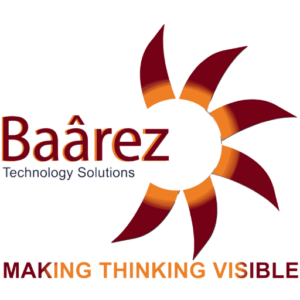
In the digital age, third-party risk management (TPRM) has become a critical component of enterprise security strategies. Baarez Technology Solutions, a leader in AI-powered risk management solutions, highlights the importance of accurately defining and calculating your organization’s risk appetite to effectively manage and mitigate third-party risks. This comprehensive guide delves into the steps and methodologies necessary for understanding and implementing a robust risk appetite framework.
Table of Contents
ToggleThe Role of Risk Appetites in Third-Party Risk Management (TPRM)
Risk appetite refers to the amount of risk an organization is willing to accept in pursuit of its objectives before action is deemed necessary to reduce it. In third-party risk management, determining your risk appetite is crucial as it guides decision-making processes, risk assessment, and mitigation strategies involving external entities such as vendors, suppliers, and service providers. Understanding and setting a clear risk appetite helps ensure alignment between business objectives and risk management practices.
Terms Overview: Inherent Risk, Residual Risk, Risk Appetite, and Risk Tolerance
Before we dive deeper, it’s essential to clarify some key terms used in risk management:
- Inherent Risk: The level of risk inherent in a particular activity or system, without taking any mitigating measures into account.
- Residual Risk: The level of risk remaining after risk response measures have been applied.
- Risk Appetite: The amount of risk an organization is prepared to accept, tolerate, or be exposed to at any time.
- Risk Tolerance: The degree of variability in outcomes related to specific risks that an organization is willing to accept.
The Risk Appetite Scale
The risk appetite scale is a tool used to quantify and communicate the level of risk an organization is willing to accept. It typically ranges from very conservative (low risk tolerance) to aggressive (high risk tolerance).
What’s the Difference Between Risk Appetite and Risk Tolerance?
While these terms are often used interchangeably, they represent different concepts. Risk appetite defines the total risk an organization is willing to take on, while risk tolerance focuses on the acceptable variation around specific risks.
How to Measure and Calculate Your Cybersecurity Risk Appetite
Calculating risk appetite in cybersecurity involves assessing the potential impacts of cyber threats and deciding how much risk your organization can tolerate.
Step 1: Identify all Regulatory Compliance Expectations
Firstly, determine all regulatory requirements that your organization must comply with, such as GDPR for data protection or SOX for financial reporting. Compliance shapes the baseline of your risk management framework.
Step 2: Identify all Relevant Inherent Risk Categories
To assess your inherent risks, consider all aspects of your organization’s operations that involve third parties.
Outsourcing Risk Examples
- Data breaches through third-party services
- Operational disruption due to third-party failures
Service-Level Agreement Risk Examples
- Non-compliance with performance metrics
- Legal liabilities from missed deadlines
Step 3: Choose a Risk Measurement Methodology
Selecting a methodology to measure risk is vital for accurate and actionable risk assessment.
Calculating the Likelihood of Cyber Risk Events
To calculate the probability of cyber risk events, organizations can use either quantitative or qualitative approaches.
The Quantitative Methodology
This involves using statistical methods to estimate probabilities based on historical data, which provides a more objective measure of risk.
The Qualitative Methodology
This method uses expert judgment to rate risks based on severity and likelihood, often resulting in a risk matrix.
Which Risk Rating Methodology Should You Choose?
The choice between quantitative and qualitative methodologies depends on the specific needs of the organization, availability of data, and the nature of the risks involved.
The Importance of Contextualization
Adapting the chosen methodology to the specific context of your organization is crucial for effective risk assessment and management.
TPRM Risk Appetite Calculation with Baarez Technology Solutions
Baarez Technology Solutions’ AI-powered TPRM solutions enable organizations to dynamically assess and manage third-party risks tailored to their specific risk appetites. By integrating cutting-edge technology and comprehensive risk assessment tools, Baarez helps ensure that third-party engagements align with corporate risk strategies.
Integrating Risk Appetite into TPRM Strategy
The successful integration of risk appetite into third-party risk management strategies is not a one-time task but a continuous process. Here’s how organizations can achieve this:
Building a Risk Appetite Framework
The first step in integrating risk appetite is to build a comprehensive framework that aligns with the organization’s objectives and third-party engagements. This framework should define clear thresholds for acceptable risk and detail specific actions to be taken when these thresholds are exceeded.
Aligning Third-Party Policies with Risk Appetite
It’s crucial to ensure that all policies related to third-party management reflect the organization’s risk appetite. This alignment helps in making consistent decisions across all levels of the organization and among all third-party relationships.
Regular Review and Adjustment
Risk appetite should not be static; it needs to evolve as the organizational environment and external threats change. Regular reviews and adjustments of the risk appetite framework ensure that it remains relevant and effective in mitigating risks associated with third-party relationships.
Enhancing Third-Party Due Diligence
Enhanced due diligence is key to effectively managing third-party risks. Here’s how organizations can strengthen their due diligence processes:
Comprehensive Risk Assessments
Before onboarding a new third party, conduct thorough risk assessments that consider the full spectrum of risks, from cybersecurity threats to compliance and operational risks. This helps in understanding the potential impact of the third party on the organization’s risk profile.
Continuous Monitoring
Implement systems for the continuous monitoring of third-party performance and risk exposure. This proactive approach helps in detecting and responding to risks before they materialize into significant threats.
Leveraging Technology in Due Diligence
Utilize advanced technological solutions, such as those provided by Baarez Technology Solutions, to streamline and enhance the accuracy of due diligence processes. AI and machine learning can significantly improve the efficiency and effectiveness of risk assessments and monitoring.
Crisis Management and Incident Response
Even with an effective TPRM framework, incidents may occur. Here’s how organizations can prepare:
Developing a Response Plan
Have a well-defined incident response plan that details the steps to be taken in the event of a third-party related security breach or failure. This plan should align with the overall risk management strategy and communication protocols.
Training and Simulations
Regular training and simulation exercises for dealing with third-party incidents are essential. These help ensure that the response team is well-prepared to act swiftly and effectively to mitigate damages.
Post-Incident Analysis
After managing a third-party incident, conduct a thorough analysis to identify the root causes and learn from the event. This analysis should feed into the continuous improvement of third-party risk management practices.
Conclusion
Calculating and managing risk appetite in third-party risk management is a dynamic and complex challenge that requires a strategic approach, continuous assessment, and the integration of advanced technological solutions. By establishing a robust framework, enhancing due diligence, and preparing for potential crises, organizations can effectively manage their third-party risks. Baarez Technology Solutions offers AI-powered tools that help businesses tailor their risk management practices to their specific needs, ensuring that their third-party engagements are both secure and beneficial. With the right strategies and tools, organizations can turn third-party risk management into a competitive advantage, fostering growth and innovation while protecting against potential threats.
Frequently Asked Questions
-
1. How to quantify risk appetite?
Risk appetite is quantified by defining the level of risk that a company is willing to accept to achieve its objectives. This is often expressed in qualitative terms and supported by quantitative measures. For example, companies can set thresholds for financial losses, compliance breaches, or operational disruptions they deem acceptable. Baarez Technology Solutions aids in quantifying risk appetite through our AI-driven analytics, providing insights that help align your risk thresholds with your strategic goals.
-
2. How do you evaluate third party risk?
Third party risk is evaluated through a comprehensive assessment that includes the examination of financial stability, cybersecurity posture, compliance with relevant regulations, and the operational resilience of the third party. Our AI-powered TPRM solution enhances this process by leveraging data analytics and machine learning to predict potential risk scenarios and assess the impact of third party relationships on your business continuity.
-
3. How do companies determine risk appetite?
Companies determine risk appetite by considering their strategic objectives, market environment, regulatory requirements, and internal capabilities. It involves collaboration across various departments, including risk management, finance, operations, and executive leadership. Baarez Technology Solutions facilitates these discussions through structured risk assessment frameworks and advanced modeling techniques, helping define clear and actionable risk appetite statements.
-
4. How do you monitor third party risk?
Monitoring third party risk involves continuous oversight of the third party’s performance and compliance with the terms of engagement. This includes regular audits, performance reviews, and monitoring key risk indicators. Our AI-powered solution automates much of the monitoring process, offering real-time alerts and analytics that enable proactive risk management.
-
5. What is risk appetite scale?
A risk appetite scale is a tool used to measure and express the level of risk a company is willing to take. The scale typically ranges from very conservative to very aggressive. It helps in categorizing risks and aligning them with the company’s strategic goals. Baarez Technology Solutions helps companies develop and implement customized risk appetite scales that reflect their unique business environment and objectives.
-
6. What is the third party risk management standard?
The third party risk management standard refers to a set of practices and procedures designed to identify, assess, and mitigate risks associated with third parties. These standards can be industry-specific or based on broader frameworks such as ISO 31000 or COSO. Our AI-powered TPRM solution is designed to comply with these standards, ensuring that your risk management practices are both effective and globally compliant.
-
7. What is an example of a risk appetite statement?
An example of a risk appetite statement is: "Our company is willing to accept a moderate level of operational risk to achieve a competitive advantage, but will not tolerate any breaches of compliance that could result in significant fines or damage to our reputation." This type of statement helps clarify the types and levels of risk a company is willing to engage with.
-
8. What are the three dimensions of risk appetite?
The three dimensions of risk appetite are:
- Quantitative Dimension: This includes specific metrics such as potential financial loss, market share impact, or operational downtime.
- Qualitative Dimension: This focuses on non-quantifiable factors such as risk culture, ethical considerations, or company values.
- Temporal Dimension: This involves the time frame over which risks are considered, recognizing that risk appetite may vary over different strategic periods or stages of a project.
For more detailed information on implementing an AI-powered Third Party Risk Management solution tailored to your business needs, please contact Baarez Technology Solutions directly.


